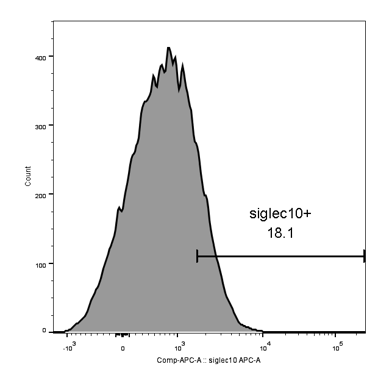Human Siglec-10 Antibody Summary
Met17-Thr546
Accession # Q96LC7
Customers also Viewed
Applications
Please Note: Optimal dilutions should be determined by each laboratory for each application. General Protocols are available in the Technical Information section on our website.
Scientific Data
 View Larger
View Larger
Detection of Siglec‑10 in Human B Cells by Flow Cytometry. Human whole blood CD19+B cells were stained with Goat Anti-Human Siglec-10 Antigen Affinity-purified Polyclonal Antibody (Catalog # AF2130, filled histogram) or isotype control antibody (Catalog # AB-108-C, open histogram), followed by Phy-coerythrin-conjugated Anti-Goat IgG Secondary Anti-body (Catalog # F0107).
Preparation and Storage
- 12 months from date of receipt, -20 to -70 °C as supplied.
- 1 month, 2 to 8 °C under sterile conditions after reconstitution.
- 6 months, -20 to -70 °C under sterile conditions after reconstitution.
Background: Siglec-10
Siglecs (sialic acid binding Ig-like lectins) are I-type lectins that belong to the immunoglobulin superfamily. They are characterized by an N‑terminal Ig-like V-type domain which mediates sialic acid binding, followed by a varying number of Ig-like C2-type domains. Siglecs 5‑11 constitute the CD33/Siglec-3 related group, and are differentially expressed in the hematopoietic system (1‑3). Siglec-G is the apparent ortholog of human Siglec-10 (4). The human Siglec-10 cDNA encodes a 697 amino acid (aa) precursor that includes a 16 aa signal sequence, a 534 aa extracellular domain (ECD), a 21 aa transmembrane segment, and a 126 aa cytoplasmic domain. The ECD contains one Ig-like V‑type domain and four Ig-like C2-type domains, while the cytoplasmic domain contains two immunoreceptor tyrosine-based inhibitory motifs (ITIM) (5‑8). Five splice variants of human Siglec-10 differ in their deletions within the ECD. A potentially secreted sixth variant contains the Ig-like V-type domain followed by a 45 aa substitution (5‑7, 9). Within the ECD, human Siglec-10 is most closely related to Siglec-5 (42% aa sequence identity). It shares 63% aa sequence identity with mouse Siglec-G. Siglec-10 is expressed on eosinophils, neutrophils, monocytes, and B cells (5, 8) with some splice variants predominating in particular cell types and tissue locations (6, 7, 9). It is up‑regulated on eosinophils in mouse models of allergic respiratory inflammation (10). Siglec-10 binds sialated proteins and lipids in alpha 2,3 or alpha 2,6 linkage and shows a preference for GT1b gangliosides (7, 11). This binding can be modulated by cis interactions of Siglec-10 with sialated molecules expressed on the same cell (7). When tyrosine phosphorylated, the cytoplasmic ITIMs interact with phosphatases SHP-1 and SHP-2 to propagate inhibitory signals (5, 9).
- Crocker, P.R. (2005) Curr. Opin. Pharmacol. 5:431.
- Crocker, P.R. (2002) Curr. Opin. Struct. Biol. 12:609.
- Crocker, P.R. and J. Zhang (2002) Biochem. Soc. Symp. 69:83.
- Angata, T. et al. (2001) J. Biol. Chem. 276:45128.
- Whitney, G. et al. (2001) Eur. J. Biochem. 268:6083.
- Yousef, G.M. et al. (2001) Biochem. Biophys. Res. Commun. 284:900.
- Li, N. et al. (2001) J. Biol. Chem. 276:28106.
- Munday, J. et al. (2001) Biochem. J. 355:489.
- Kitzig, F. et al. (2002) Biochem. Biophys. Res. Commun. 296:355.
- Aizawa, H. et al. (2003) Genomics 82:521.
- Rapoport, E. et al. (2003) Bioorg. Med. Chem. Lett. 13:675.
Product Datasheets
Citations for Human Siglec-10 Antibody
R&D Systems personnel manually curate a database that contains references using R&D Systems products. The data collected includes not only links to publications in PubMed, but also provides information about sample types, species, and experimental conditions.
3
Citations: Showing 1 - 3
Filter your results:
Filter by:
-
Decidual glycodelin-A polarizes human monocytes towards a decidual macrophage-like phenotype via siglec-7
Authors: M Vijayan, CL Lee, VHH Wong, X Wang, K Bai, J Wu, H Koistinen, M Seppälä, KF Lee, WSB Yeung, EHY Ng, PCN Chiu
J. Cell. Sci., 2020-07-23;0(0):.
Species: Human
Sample Types: Whole Cells
Applications: Neutralization -
Preferential use of Siglec-1 or Siglec-10 by type 1 and type 2 PRRSV strains to infect PK15S1-CD163 and PK15S10-CD163 cells
Authors: J Xie, I Christiaen, B Yang, I Trus, B Devriendt, T Cui, R Wei, HJ Nauwynck
Vet. Res., 2018-07-18;49(1):67.
Species: Porcine
Sample Types: Whole Cells
Applications: ICC -
Alteration and acquisition of Siglecs during in vitro maturation of CD34+ progenitors into human mast cells.
Authors: Yokoi H, Myers A, Matsumoto K, Crocker PR, Saito H, Bochner BS
Allergy, 2006-06-01;61(6):769-76.
Species: Human
Sample Types: Cell Lysates
Applications: Western Blot
FAQs
No product specific FAQs exist for this product, however you may
View all Antibody FAQsIsotype Controls
Reconstitution Buffers
Secondary Antibodies
Reviews for Human Siglec-10 Antibody
Average Rating: 4.5 (Based on 2 Reviews)
Have you used Human Siglec-10 Antibody?
Submit a review and receive an Amazon gift card.
$25/€18/£15/$25CAN/¥75 Yuan/¥2500 Yen for a review with an image
$10/€7/£6/$10 CAD/¥70 Yuan/¥1110 Yen for a review without an image
Filter by:


















